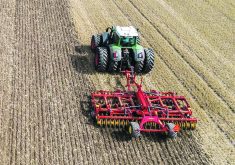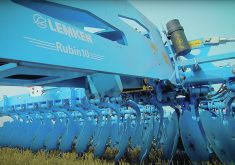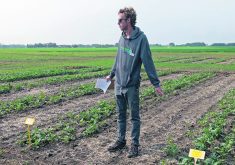Another no-till seed drill option for farmers will soon hit the market as European manufacturer debuts new implement
Prairie farmers have seen the number of no-till drills on the market grow significantly over the past two decades. Soon, one more will be added to that group, one with a very international pedigree. Germany-based Lemken, which has had a strong presence in the tillage implement market here for several years, has announced it intends to bring its recently acquired Equalizer drill to the Canadian market.
Lemken has bought the company building the Equalizer drill, which is based in South Africa. Equalizer planters, air disc drills, Air Tine drills and air carts have been predominantly sold there and in Australia, where seeding conditions are roughly similar to those here.
“We developed the drill as a single-pass system about 23 years ago,” says Gideon Schreuder, managing director of Equalizer.
“Today we’re the market leader in South Africa for precision planting. We’ve had a lot of success with the same single-pass system.”
Lemken believes the drill can also make a significant impact in the western Canadian market and intends to retail it through its dealer network.
However, before it begins commercial release, the company intends to spend the rest of 2023 and at least part of 2024 conducting field trials in as many locations and soil types across the Prairies as possible.
“(Field trials) is our main purpose now for fall,” says Schreuder. “We’re bringing in some more machines for the spring of next year to get broader exposure to more soil conditions. So this is a learning process for us.”
The Equalizer drill was designed for small grains and can easily handle small-seeded crops such as canola. It’s metering system features a built-in brush that continually cleans the rollers to prevent buildup of fertilizer residue to maintain a high degree of accuracy.
“What is unique on our drills is the metering systems,” says Schreuder.
“We have a self-cleaning metering roller with a brush on it. It’s a very unique shape of roller. The brush is constantly cleaning that metering roller, so the shape of it doesn’t change over time with buildup, of fertilizer specifically. From a consistency point of view, you will go far to find anything better than that. For durability, everything is made of stainless steel on the casing. The roller is polyurethane, so its longevity is exceptional.”
Another unique feature of the drill is its “vertical banding” concept. It’s a shank drill, and the lead shank places the fertilizer. It can dig down as much as six inches, placing the fertilizer well below the seed trench. The opener then closes the furrow and places the seed above it. Fertilizer depth placement is controlled by the frame height, while seed depth is controlled in quarter-inch increments by adjusting the rear packer wheel position. It has nine depth settings. The rear packer wheel also pivots to more accurately follow the seed trench during turns.
However, the deeper working depth will demand a little more from a tractor compared to typical side-banding shanks, which run much shallower.

“Horsepower requirements will be a little bit higher because we go deeper in (for fertilizer placement),” Schreuder says.
“I would say we are about 20 percent more.”
The Equalizer drill will be available in 40, 50, 60 and 80-foot working widths. Two row spacings are available: 10.5 inches and slightly less than 12 inches. The brand offers both tow-behind and tow-between carts.
Schreuder believes there may be limited retail sales in 2024, but he expects sales will probably be in full swing the following year.
“2024 is going to be limited numbers still,” he says. “We’re looking forward to 2025, if everything goes according to plan. We foresee we might have to make some modifications to better handle the heavy clay soils.”
In the meantime, Schreuder says the company is actively looking for growers who are willing to have the drill brought to their farm this fall or next spring to do some seeding as part of the company’s extensive field trials program.
Interested producers can contact any Lemken dealer.















